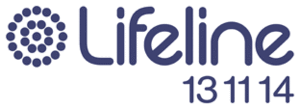Lifeline (crisis support service)
Lifeline is a non-profit organisation that provides free, 24-hour telephone crisis support service in Australia. Volunteer crisis supporters provide suicide prevention services, mental health support and emotional assistance, not only via telephone but face-to-face and online.
 "An Australia Free of Suicide" | |
| Founded | 16 March 1963 |
|---|---|
| Founder | Reverend Dr Sir Alan Walker |
| Location |
|
Area served | Australia |
| Product | Telephone and Online Crisis Support |
Key people | CEO: Bob Gilkes Chairman: John Brogden AM National Patron: |
Volunteers | Over 11,000 |
| Website | www |
The telephone service can be accessed by calling 13 11 14 within Australia.
Telephone crisis support is provided via a network of Lifeline Centres maintained by trained volunteers and some paid staff. As at March 2018, there are 40 Lifeline Centres, spanning across 60 locations around Australia. About 11,000 volunteers deliver support services, while approximately 1,000 staff provide administration and fundraising co-ordination.
Some Lifeline Centres also provide other support services which may include face-to-face counselling, group support, assistance with food and utility bills, support for the elderly and frail, and related services.
Lifeline has over 260 retail outlets around the country which sell a variety of clothes, furniture and bric-a-brac. Some Lifeline Centres have a number of stores but not all Lifeline Centres have retail outlets.
History
Lifeline was founded in Sydney, New South Wales, in 1963 by the late Sir Alan Walker after a call from a distressed man who three days later took his own life. Determined not to let loneliness, isolation and anxiety be the cause of other deaths, Walker launched a crisis line which initially operated out of the Methodist Central Mission.[1]
Lifeline Sydney was two years in planning and preparation, with 150 people attending a nine-month training course to work at the Centre. A century old, dilapidated building owned by the Mission, on the fringes of downtown Sydney was renovated for the purposes of this new support centre. A staff of full-time employees was appointed to direct the work of these new telephone crisis support 'workers'. The Director General of Post and Telephone Services authorised that this crisis support service should be listed on the Emergency Page of the Telephone Directory and the phones were installed.[1]
March 1963 saw the opening of the first official Lifeline Centre. The initiative was well received with over 100 calls for help being answered on the first day. The first call came one minute after the lines were opened and the phones have never stopped ringing.
In January 1964, Lifeline was featured in an article in Time magazine,[2] which helped lead to the establishment of similar services around the world.
The first international convention of Lifeline was held in Sydney in August 1966 to guide the development of Lifeline services and to establish quality standards, which led to the formation of Lifeline International.
In 1994, Lifeline transitioned the 24-hour telephone crisis support line to a single national priority 13 number (13 11 14).
In 2007, Lifeline introduced national call flow to the 24-hour service. This allowed Lifeline to begin flowing calls nationally over a wide area network, to be answered by the next available telephone support volunteer, anywhere in the country.
Usage
Lifeline receives about one million requests for help every year. In the 2016-17 financial year, the national charity received 933,408 calls to its 13 11 14 crisis line and 53,257 requests to its online Crisis Support Chat service.[3] In 2016/2017, Lifeline reported an income stream consisting of 13% from community support, 72% through government grants and 15% from other sources.[3] Income is then distributed to: service support (84%), fundraising and promotion (9%), and administration (7%).[3]
In March 2020, Lifeline responded to almost 90,000 calls, equivalent to one every 30 seconds. On Friday 10 April 2020, Lifeline received 3200 calls, the single busiest day in the organisation's history.[4]
Confidentiality
Despite allowing for anonymity, Lifeline will contact authorities and identify the caller in cases where they believe the person may be serious in taking their own life. Lifeline will disclose caller information if "we reasonably believe that the disclosure will prevent or lessen a serious and imminent threat to somebody's life, health or safety (including your own) or serious threat to public health, property or public safety".[5]
Locations
Australian Capital Territory: Canberra
New South Wales: Broken Hill; Central Coast; Central West; Harbour to Hawkesbury; Macarthur; Mid Coast; Mountains to Murray; Newcastle & Hunter; North Coast; Northern Beaches; Northern Rivers; North West; South Coast; Sydney & Sutherland; Western Sydney
Northern Territory: Alice Springs
Queensland: Brisbane; Cairns Region; Central Queensland; Coral Coast Capricorn; Darling Downs and South West Queensland; Fraser District; Gold Coast; Greater Sunshine Coast Region; Ipswich & West Moreton; Mackay-Whitsunday; North Queensland
South Australia: Adelaide; Country to Coast; South East
Tasmania: Hobart
Victoria: Ballarat; Central Victoria & Mallee; Geelong Barwon Region; Gippsland; Melbourne; South Western Victoria
Western Australia: Western Australia
References
- "Archived copy". Archived from the original on 25 July 2010. Retrieved 24 April 2010.CS1 maint: archived copy as title (link)
- "Evangelism: Throwing Out the Life Line". Time. 24 January 1964.
- "Lifeline Annual Report 16/17".
- Ilanbey, Sumeyya. "'Our world has been turned upside down': Mental health gets $60 million lifeline". The Age. Fairfax Media. Retrieved 13 April 2020.
- Lifeline Privacy Policy, section 6.1.